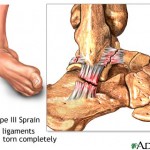Brief Outline of Ankle Pronation
Pronation is the inward rotation of the foot during walking or running. While some pronation is natural and part of the normal gait, excessive pronation can lead to some chronic injuries, and acute over-pronation can lead to strains or sprains.

Anatomy and physiology
The ankle is a hinge joint and is formed of the seven tarsal bones. The two largest tarsals carry the body weight: the calcaneus, or the heel bone, and the heel bone, and the talus, which lies between the tibia and the calcaneus. The tibia and fibula rest on top of the talus. Pronation occurs at the subtalar joint. The strong ligaments of the ankle help provide support and prevent excessive pronation. The muscles of the calf and the anterior muscles of the lower leg also offer support. When these ligaments are loose or the muscles fatigue, the support is lost, which results in more pronation. This causes the arch of the foot to flatten out, which in turn further stretches the ligaments. Also, during weight bearing at midstance, there is a tendency for calcaneal eversion and foot abduction, as the foot moves into dorsiflexion.
Cause of Ankle Pronation
Loose or torn tendons from previous ankle injuries. Weak or fatigued muscles of the lower leg. Improper or worm footwear. Uneven running (or landing) surfaces.
Signs and symptoms of Ankle Pronation
Pain in the arch, heel, and/or knees and hips. Pain during the landing phase of running or jumping. Visible inward rolling of the foot and ankle. Instability in the ankle. Pain may be immediate for acute over-pronation, such as an ankle sprain, or gradual for chronic pronation disorders.
Complications if left Ankle Pronation Unattended
Pronation has been attributed to shin splints, plantar fasciitis, chondromalacia patelle, tendinitis, and even stress fractures. The longer pronation continues, the more the ligaments of the foot and ankle will be stretched, leading to ankle instability. The arches may flatten out and lead to other problems of the foot. Chronic pronation of the foot beyond normal ranges can lead to overuse and chronic injuries.
Treatment for Ankle Pronation
Rest, ice and anti-inflammatory medications may help alleviate pain. For acute injuries, immobilisation and reduction of weight bearing activities may be required. For chronic injuries, seek the help of a qualifed orthopaedic specialist to help identify and correct the problem.
Rehabilitation & Prevention for Ankle Pronation
Correct the underlying problem, e.g. if due to the running surface, change the surface to one that is flat and smooth. If due to footwear, try some new or different shoes. If necessary, use orthotics and gait training. Warm-up properly. Stretching and strengthening will offer support and keep the muscles of the lower leg strong and flexible. Completely rehabilitate any ankle injury before returning to sport to prevent any re-occurence.
Long-term Prognosis for Ankle Pronation
Will usually respond well to treatment, although the longer pronation goes untreated and allowed to cause damage to the ligaments, the longer the recovery time. In very rare cases, surgical intervention may be required to correct any underlying orthopaedic issues.
